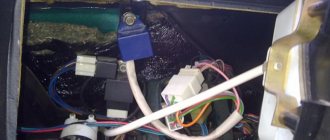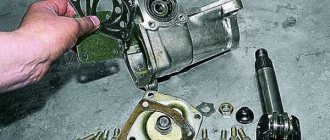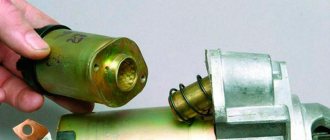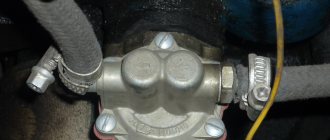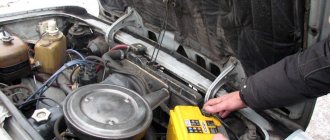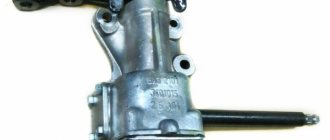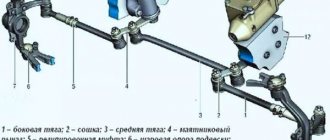Maybe I'm exaggerating, but it seems to me that every classic encountered such a problem. In the heat, when the car was moving (in my case it was a VAZ 2106), the car began to twitch or completely stall in the most inconvenient places (crossroads, on the highway, etc.). If you open the hood and look at the fuel filter at this time, you could notice that it is empty or there is very little gasoline there; when you try to manually pump gasoline from the fuel pump, you can understand that the fuel pump does not pump gasoline. Everyone solves this problem in their own way, I let the engines cool by 10-15 degrees, then moistened a rag, threw it on the gas pump, successfully started the engine and drove home. (I want to make a reservation right away, I always had a new fuel pump repair kit in the car, I have a DAAZ fuel pump. Pekar g * but there were two of them, the same problems with them.) In general, I removed the fuel pump, took it home, disassembled it, to my To my surprise, everything was fine with it, the diaphragms were not torn, the valves were normal, but since I had a repair kit, I replaced everything with a new one and installed it on the car. The problem has not gone away. Air jams still formed. Then I went to an auto store, bought a fuel pump pusher, it was 8.25 cm long, took off the old one, measured it, its length was 8.2, the difference in principle is not big, I installed a new pusher, drove it, and still the problem did not disappear. I no longer knew what the reason could be, I also went to the auto store, bought a rod with a pusher, removing the old rod with a pusher, I noticed that the rod was cracked, + in addition to all this, there is a 1mm thick gasket between the block and the rod, not order! There should be a gasket with a thickness of 0.27-0.3 mm... Next, installing a new rod + a new pusher that came with the rod, I adjusted the protrusion of the pusher to 1.1 mm (0.8-1.3 seems to be allowed). I installed a new fuel pump (because I had ruined the old one) and that was it, my problems disappeared. I still think that the problem was in the rod and an incorrectly installed gasket, but what’s most interesting is that we drove like this for almost 3 years, with an incorrectly installed gasket. But at the same time, every summer I had to buy a new fuel pump, because this only solved the problem of an air lock...
That's all, if someone solved this problem differently, please leave a comment, I will be very grateful to you
When operating the “seven”, one of the problematic components is the fuel pump. Sometimes its malfunctions have to be fixed urgently, “on the road”. Therefore, it will be useful for every owner of the “Seven” to know how the VAZ 2107 fuel pump (carburetor) works, what its main malfunctions are and how to repair it.
Functions and structure of the VAZ 2107 fuel pump (carburetor)
The fuel pump is a key component of the engine power supply system. The function of the pump is to supply gasoline from the fuel tank to the carburetor float chamber. The fuel pump on carburetor VAZ models is installed on the side of the cylinder block, inside the engine compartment.
The specific design of the pump makes the fuel pump one of the weak points of the power system. Contamination and poor quality gasoline, constant loads leading to natural wear of parts often cause unit failure. As a result, the gasoline supply stops and the engine stops working.
The VAZ 2107 fuel pump consists of the following parts:
- pusher;
- spring;
- balance;
- lid;
- cover screw;
- screw;
- mesh filter;
- membranes (working and safety);
- lower and upper plates;
- stock;
- valves (inlet and outlet);
- manual pumping lever.
The VAZ 2107 fuel pump works like this:
- The reciprocating movements of the pusher are ensured by the joint work of the drive cam and the return spring.
- working membranes move, creating alternately pressure and vacuum in the working chamber;
- when the pressure decreases, the exhaust valve closes, gasoline begins to flow from the gas line through the opening inlet valve;
- as the pressure increases, the inlet valve closes, and gasoline is pumped through the outlet valve into the hose leading to the carburetor.
Why does the pump stop pumping?
Carburetor K-151: device, adjustment, repair, connection, photo
A node can fail for various reasons. But most often this happens due to:
- Resource development.
- Destruction of elements due to incorrect assembly during repairs.
- Destruction of elements due to manufacturing defects.
Be sure to make sure that there is gasoline in the tank, that the filter and the tubes going to it are not dirty. After this, you can only look for the cause of the breakdown of the VAZ-2106 fuel pump. They can be caused by:
The fuel pump rod was
at VAZ
2107.stock
It was worn down by 4-5 mm, so the fuel didn’t work...
How to adjust the fuel pump VAZ 2106
Replace
The fuel pump is very simple, you just need to disconnect the fuel hoses, unscrew two nuts...
- Strong production of rubbing components.
- Destruction of the diaphragm.
- Loss of elasticity of the spring or its destruction.
- Accumulation of dirt inside the valves.
Sometimes the car starts to behave strangely - at low speeds the engine runs stably, but at high speeds it starts to stall. In this case, you need to check the pressure generated by the fuel pump. There are two reasons for this behavior - insufficient fuel level in the float chamber and excessive wear of the VAZ-2106 fuel pump rod.
Reasons for the malfunction of the VAZ 2107 fuel pump
- Depressurization of the working chamber due to wear of the sealing gasket. This causes fuel to leak out of the pump or air to be sucked in instead of gasoline.
- Clogged valve channels (intake and exhaust), as a result of which the valves cease to perform their functions. The problem can be prevented by installing a fine filter in the fuel line in front of the fuel pump.
- Wear and distortion of valve parts. The result of the misalignment is the same as when the valves are clogged, but identifying and eliminating the problem is quite difficult.
- Rupture of the working membrane. Pressure drops cease to form in the working chamber, and the pump loses its functionality.
- Damage to the safety chamber. Gasoline begins to enter the engine crankcase, where it dilutes the engine oil. If the problem is not noticed in time, the engine may seize.
Purpose
In an injection engine, fuel must be supplied to the combustion chamber under pressure; this is necessary so that the fuel injectors accurately spray the fuel into small particles for easier mixing with air. The pressure is pumped up by the fuel pump, which has quite powerful characteristics and is capable of pumping up pressures of up to 10 bar. Of course, this pressure is not used in a car, it is regulated by a special sensor that resets it at 4 bar.
Troubleshooting the VAZ 2107 fuel pump
Before checking the fuel pump, it is advisable to stock up on M8 bolts or other products of a similar diameter that can serve as plugs for fuel hoses.
To check the VAZ 2107 fuel pump, you must perform the following steps:
- Loosen the hose clamp that supplies gasoline to the carburetor and remove the hose from the fitting.
- Plug the fuel hose to prevent fuel from spilling out.
- Pump the fuel pump manual drive lever several times. If a stream of gasoline comes out of the outlet fitting, the fuel pump is working. If not, the check should continue.
- Loosen the inlet hose clamp, remove the hose and plug it in the same way as before.
- Close the inlet fitting with your finger and pump the hand drive lever several times. If there is a noticeable vacuum, the problem is not in the fuel pump. If the finger does not “stick”, it is necessary to remove and repair or replace the fuel pump.
Replacing the fuel pump VAZ 2107
The easiest way to restore engine operation if the fuel pump breaks down is to replace the latter. Replacing the VAZ 2107 fuel pump is done as follows:
- clean the area where the fuel pump meets the cylinder block using white spirit or WD-40;
- loosen the fuel hose clamps;
- remove the hoses and plug them with M8 bolts or something similar, for example. plastic choppers;
- Using a 13mm wrench, unscrew the two nuts securing the fuel pump to the engine;
- remove the old fuel pump from the studs and install a new one;
- secure the new fuel pump with nuts;
- connect the fuel hoses and tighten the clamps.
Types of systems
For decades, while the VAZ 2107 model was produced (from 1982 to 2012), it was equipped with three types of ignition systems:
- mechanical with contacts - breakers;
- contactless;
- controlled by an electronic unit (ECU).
Contact ignition circuit installed in the first VAZ 2107 models
In the mechanical version, the contacts opened by the cam of the distributor shaft break the low voltage circuit, initiating the formation of a powerful pulse in the secondary winding of the coil. This discharge is directed to the electrodes of the spark plug, which ignites the fuel in the cylinder where the piston has risen to top dead center (TDC) and the compression stroke is completed.
Scheme of non-contact ignition of the seven with a carburetor
The contactless circuit operates on the same principle, only the signal to break the circuit is supplied by the Hall sensor, and it is implemented by the switch. Therefore, setting the ignition on carburetor “sevens” is done almost identically. Another thing is cars with an injector, where a new system has been introduced that does not have not only contacts, but also a distributor and any moving parts. Here, the moment of spark formation is determined by the ECU controller, which is guided by the signals of various sensors.
Ignition system VAZ 2107 with injector
Repair of fuel pump VAZ 2107
Repairing the VAZ 2107 fuel pump instead of replacing it is a much more rational decision from a financial point of view. To do this, you need to remove the unit. The procedure for removing the fuel pump is described in the previous section “Replacing the VAZ 2107 fuel pump”.
After the fuel pump is removed, you can begin to disassemble it and check the parts for damage or wear.
It's worth starting with gaskets. The thickness of the gasket between the fuel pump and the thermal insulating plastic spacer must be more than 0.3 millimeters. The gasket between the spacer and the cylinder block must be thicker than 0.8 millimeters.
The most common failure of a fuel pump is a rupture of the working diaphragm. To replace it, you need to unscrew the cover bolt and pull out the diaphragm assembly (rod with attached diaphragms). To replace them, simply unscrew the nut on the rod. You should also check the serviceability of the return spring and replace it if necessary.
When the cover is removed, the strainer becomes accessible and should be cleaned of dirt and inspected for damage before reinstalling.
The fuel pump valve channels should be cleaned and checked to see if they are loose in their seats. If play is noticeable, the valve should be replaced. If the cause of the play is a broken seat, the malfunction cannot be eliminated. You only need to replace the fuel pump.
In some cases, the tightness of the working chamber of the fuel pump is broken due to deformation of the cover. In this case, you can try to select and install a whole cover from an old fuel pump.
The fuel systems of classic VAZ models, such as 2106 and 2107, differ in the type of supply of the combustible mixture to the cylinders. For some, the carburetor is responsible for this, for others, the injector. However, the coordinated operation of the power unit for both depends not on the design of the system, but on the serviceability of its elements, and primarily the fuel pump. Every car enthusiast should, if necessary, be able to repair and replace this element with his own hands.
Video
The process of repairing a DAAZ fuel pump using a repair kit is shown below:
And this is the repair of the PEKAR fuel pump:
Over time, the fuel pump becomes clogged and begins to pump gasoline poorly. Because of this, you will often stall, and sometimes this can even lead to engine problems. The fuel pump on the VAZ 2106 itself consists of a small number of parts, so you can repair it yourself. Let us recall that in the previous article we looked at how to replace the thresholds on a VAZ 2106 with your own hands in a garage.
Repair of fuel pump VAZ 2106
1. Unscrew the cover bolts on the pump. 2. The first thing that appears to us is a mesh filter. We're filming that too. 3. Use a screwdriver to press on the inlet valve. We are inspecting it. If necessary, we “seat” it tightly into the “saddle”. 4. Next you need to prepare a bath with solvent. We will wash the filter in it.
5. After washing, the filter is blown with compressed air so that no dirt remains inside.
6. The fuel pump housing consists of two solid halves. To separate them, unscrew the six bolts that connect them. 7. Having received two halves, we check the exhaust valve. The check is carried out identically to the intake valve check. The same washing, the same blowing. 8. Remove the diaphragm assembly from the housing. This can be done in a counterclockwise circular motion. You need to turn it about ninety degrees. 9. Remove the spring from the rod. 10. Unscrew the nut on the steel cup.
What fuel pumps were equipped with classic VAZ models?
Classic VAZs include all models of the Zhiguli family, produced from 1970 to 2012 and their modifications:
- VAZ 2101;
- VAZ 2102;
- VAZ 2103;
- VAZ 2104;
- VAZ 2105;
- VAZ 2106;
- VAZ 2107.
Depending on the year of manufacture, the engines of these vehicles were equipped with different fuel systems. In all the first Zhiguli models, the fuel mixture was injected into the cylinders using a carburetor, and the fuel was supplied by a mechanical fuel pump. The latest modifications of the VAZ 2104, 2105 and 2107 had an injection system and an electric fuel pump.
Carburetor cars of the Zhiguli family were equipped from the factory with mechanical fuel pumps of the diaphragm type DAAZ 2101 (catalog number 1106010) produced by the Dimitrovgrad Automotive Unit Plant. Thanks to their simple design, reliability and maintainability, they have proven themselves well not only on the “classics”, but also on cars of the Sputnik and Samara families, which were equipped with their modified versions.
Carburetor VAZ 2101–2107 were equipped with DAAZ mechanical fuel pumps
Injection Zhiguli models were equipped with domestically produced electric fuel pumps. They were produced by the Pekar and Utes enterprises under catalog number 21073–1139009. The latest modifications of the Zhiguli were equipped with products (catalog number 2112–1139009). The same devices were installed on all models of the Samara and Lada families.
Injection models of classic VAZs were equipped with electric fuel pumps “Pekar”, “Utes”, “Bosch”
Preparatory stage
To set the ignition on a VAZ 2107 car, no special conditions are required; the operation can be done both in the garage and on the street, including in winter. For work, prepare the following set of tools:
- flat screwdriver;
- metal probe 0.35 mm thick;
- open-end wrench size 13 mm;
- a car light bulb designed for a voltage of 12 V with wires soldered to it;
- a wrench with a long handle designed to turn the crankshaft;
- key for unscrewing spark plugs.
Ignition tuning tool
Ideally, it is better to have in your arsenal a device for setting the ignition on a running engine - a strobe light. It is equipped with a lamp that flashes simultaneously with the moment of spark formation in the cylinder, which allows you to see the position of the notch on the crankshaft pulley at idle speed and clearly adjust the advance angle.
This is what a strobe looks like, which is convenient for adjusting ignition timing
Important point. The ignition is set in order to ensure that the spark appears in a timely manner and the engine starts, after which additional adjustments will be required. But the latter will not bring you the desired result when there is no compression in the cylinders or problems with the carburetor make themselves felt. If these faults are not eliminated, the engine operation will remain unstable, no matter how you configure the spark generation system.
Checking, repairing and replacing a mechanical fuel pump
Methods for diagnosing fuel pumps for carburetor and injection engines of Zhiguli are also different. Checking a mechanical pump consists of determining its performance, as well as assessing the condition and performance of its component elements.
How to check the performance of a mechanical fuel pump
The productivity of the DAAZ mechanical pump is 1 liter per minute. To check the amount of pumped fuel you will need:
- a piece of gas-resistant hose (50–80 cm);
- 2 clean containers with a volume of at least 2 liters (plastic bottles are acceptable);
- 1.5 liters of gasoline;
- watch with stopwatch;
- crosshead screwdriver;
- assistant.
- Using a screwdriver, unscrew the screw on the clamp of the pump outlet fitting. We remove the hose from it.
Remove the fuel hose from the outlet fitting
We estimate the amount of fuel pumped by the pump per minute
If the amount of gasoline is less than 1 liter, the fuel pump is faulty.
Assessment of the condition and performance of component parts
The following pump elements must be checked:
- intake and exhaust valves;
- mesh filter;
- diaphragms;
- pusher (rod).
Design of the DAAZ fuel pump
- crosshead screwdriver;
- slotted screwdriver;
- key to 10;
- key to 13;
- caliper or ruler.
- Loosen the screws of the clamps of the inlet and outlet fittings of the pump, remove the hoses from them. We place a finger on the outlet fitting, and with the other hand we press the manual pumping lever several times. You should feel the air escaping under pressure with your finger. Next, plug the inlet fitting with your finger and pump it up manually again. A vacuum should be felt at the pump inlet, i.e. the finger should be sucked inside the fitting. If nothing like this happens, the valves of the device are faulty and must be replaced.
Checking the valves consists of determining the air pressure at the outlet fitting and the vacuum at the intake
The mesh filter should not show signs of damage or deformation
If the pump diaphragms are damaged or deformed, they must be replaced.
Removing the pump thermal spacer
The length of the pusher should be 82.5 mm
Do-it-yourself repair of a mechanical fuel pump
It is not advisable to purchase faulty fuel pump parts separately. It is much more profitable to purchase a repair kit, which includes elements that may fail, namely:
- valves;
- set of diaphragms;
- pusher;
- thermal spacer;
- gaskets and washers.
Fuel pump repair kit
Repairing a fuel pump involves dismantling and disassembling it. They are produced according to the same algorithm that was described earlier in the diagnostics section. If, after disassembling the fuel pump body, you find that there is dirty deposits or debris on its walls or on the inner surfaces of the fittings, clean them with carburetor cleaning fluid and a piece of coarse cloth. When removing plaque, use a small wooden spatula and toothpicks. It is highly undesirable to use metal objects for these purposes.
To replace the pump valves, they will need to be removed from their seats. To do this, using a thin slotted screwdriver or knife, you need to knock out three cored areas in each of the sockets, after which the valves will come out of them freely. Having installed new parts in place of the faulty ones, the sockets must be cored again by hitting the edge with a core (screwdriver) in three places.
Replacing fuel pump valves
Important: when replacing valves, do not confuse the intake and exhaust!
In order to replace the diaphragms, you need to unscrew the nut in the upper part of the rod on which they are mounted with a 10mm wrench, then remove them and install new ones in their place in a certain order. The lowest diaphragm is the safety diaphragm. This is followed by a small and large spacer, and on top of them are two other (working) membranes.
As for the thermal spacer, it rarely fails. More often there is a manufacturing defect, which manifests itself in the unevenness of the mating plane to which the pump housing is attached. This may cause oil leakage. To replace the spacer, remove the old one from its seat, remove the old gasket from under it, and install a new spacer with the corresponding gasket from the repair kit.
Installing pump gaskets
The DAAZ fuel pump repair kit includes three gaskets of different thicknesses:
Gasket “A” is installed between the cylinder block and the thermal spacer, and the other two are used to adjust the protrusion of the pusher (rod) above the mating plane of the spacer.
Determination of the protrusion of the pusher
We install the new rod in place, and slowly turn the engine crankshaft (using the wrench on the pulley nut), select the position when the rod is extended to its minimum length. We place gasket “B” on the mating plane of the spacer and measure the amount of rod overhang above it with a caliper. It should be 0.8–1.3 mm. If the offset is greater, instead of spacer “B” you need to install spacer “C”, and if it is less, swap the first and second positions. Having achieved the result, we put the fuel pump in place and secure it with nuts. For greater tightness of the joint, the gaskets can be lubricated with a thin layer of automotive sealant.
Diagnostics and replacement of the electric fuel pump on cars of the Zhiguli family
In injection engines of classic VAZs, the fuel pump may lose its functionality both due to problems with the power supply to it and due to a malfunction of its electric motor. In the first case, the situation can be corrected by diagnosing and repairing the electrical circuit of the device. But if the electric motor of the pump fails, only replacing it will help.
Checking the protection devices for the electrical circuit of the fuel pump on injection VAZs of the Zhiguli family
If there is a problem with the electrical equipment of the fuel pump circuit, it usually does not turn on at all. Turn on the car's ignition without starting the engine and listen. First, you should hear a click from the relay, and then a characteristic “squeal” emitted by the pump’s electric motor. If you don’t hear anything like this, start diagnosing with the electrical circuit of the device.
The pump circuit is connected to the on-board network via a separate relay, and its protection is provided by a fuse. Both of these devices are located in the vehicle's optional mounting block. You will find it under the glove box. It contains 3 relays and 3 fuses. The fuel pump relay (indicated R2 in the diagram) is located in the middle, and the fuse (F3) is to the left of it. We pull the fuse out of its seat and check it by “ringing” it with a tester. If a malfunction is detected, we replace it, not forgetting to comply with the rating (15 A).
You can check the functionality of the relay by installing a known working device in its place. Instead, replace it with the relay located to the right of the one being diagnosed, which is responsible for the radiator fan circuit. If this option does not suit you, turn on the ignition and measure the voltage between the pink wire going to the relay and the vehicle ground. The device should show 12 V. This means that the device is powered. After this, you need to connect the pink wire with the gray one at the relay terminals. So we will connect the fuel pump directly to the battery. If it works (that same “squealing” sound will be heard), simply replace the relay.
The fuel pump relay is located in the middle (R2), and the fuse is located to the left of it (F3)
Checking the fuel pressure in the system
The main indicator of the operation of a fuel pump is the pressure it creates in the system. If the device turns on, pumps fuel, but the engine runs intermittently, take the time to check the pressure. To do this, you will need a pressure gauge with a measuring range of 5–7, equipped with a gas-resistant hose and a threaded fitting (if there is no special one, you can use a regular tire pressure gauge). The sequence of actions is as follows:
- On the fuel rail we find a fitting closed with a plastic cap. Unscrew the cap and connect the pressure gauge hose to the fitting. If your device is not equipped with a special threaded fitting, the hose can be secured to the “nipple” using a small clamp.
Pressure connection
The pressure in the ramp should be 2.8–3.2 atmospheres
When removing the vacuum hose from the regulator, the pressure should drop by 0.2–0.7 atmospheres
Replacing the fuel pump on injection Zhiguli cars
You can replace the fuel pump either as an assembly (install a new fuel module) or separately (change only the pump). The cost of a new domestically produced module with a fuel level sensor is 2800–3000 rubles. The production pump itself will cost 500 rubles less.
Replacement Tools:
- slotted and Phillips screwdrivers;
- key to 10;
- key to 7.
Work order:
- Disconnect the negative terminal from the battery.
- Open the gas tank cap.
- Using a slotted screwdriver, remove the rubber apron from the neck of the tank. Disconnect the safety valve tube from it.
Use a slotted screwdriver to pry off the apron
Unscrew the screws securing the gas tank trim
Unscrew the tank clamp bolt
Disconnect the electrical wiring, fuel line hoses, unscrew the nuts securing the fuel module cover
Removing the fuel module from the gas tank
Disconnect the fuel filter
Disconnect the pump power cables
Use a screwdriver to move the clamps and remove the pump from the casing.
Disconnect the tube from the outlet fitting
After installing the pump, it is advisable to check the pressure in the system as described above.
Replacing the fuel pump in cars of the Zhiguli family does not require the car owner to have extensive knowledge in the field of auto repair, and does not take a lot of time and money. It can be done without any problems in a garage, or right on the street. However, if you do not have the necessary tools or the desire to do this yourself, it is better to turn to specialists.
What is the device in question?
The fuel pump on a VAZ 2107 car, the injector is presented in the form of an electric motor with a pump that pumps gasoline from the tank.
The pump is equipped with an electric motor powered from a 12 V vehicle network. The design of the electric motor consists of a rotor, brushes and a commutator, which are constantly running on gasoline. Many will think that such a fuel system for a VAZ-2107 injector is quite dangerous, but not everything is so simple.
Spark and gasoline are a dangerous compound that can lead not only to fire, but also to explosion. This could happen, because sparks occur in the electric motor of the gasoline pump, if not for the fact that gasoline belongs to the category of liquids that do not conduct electricity. In addition, gasoline does not burn if there is no air and the fuel circuit is tightly closed. Therefore, the design of an electric fuel pump on a VAZ 2107 car is presented.
Car owners find out where the VAZ 2107 injector fuel pump is located only if it is suspected of being faulty. On the seventh carburetor, this device is located in the engine compartment next to the engine. Many may think that this device is located there on the injection seven, but no. The device is located directly in the car’s gas tank, which simplifies the fuel pumping system. If you open the trunk and lift the carpet, you can see its outlet pipes. This arrangement of the device in question simplified the process of pumping fuel, but, therefore, made it difficult to access and replace the product in the event of a breakdown.
The principle of operation of the device is quite simple. After turning the ignition key, power is supplied to the electric motor terminals, causing the pump to pump gasoline into the system until a certain pressure is created. When the pressure rises, you can start the engine. When the internal combustion engine is started, the fuel pump continues to operate throughout the entire period of engine operation, maintaining pressure in the fuel system. After turning off the engine, the pressure in the system remains for some time for several minutes, after which, if the engine has not been restarted, it decreases.
Causes of malfunctions and their diagnosis
To find out the cause of the fuel pump malfunction, you will need to pay attention to the characteristic symptoms. In this case, the device in question is diagnosed. The easiest way to check the fuel injector pump of a VAZ 2107 is to turn on the ignition and listen to the characteristic noise. If the fuel pump does not pump fuel, there will be no characteristic hum in the area of the gas tank. The reasons may be different:
- Faulty relay. If the relay is faulty, then no voltage will be supplied to the motor terminals, which means the device will not work.
- Pump malfunction. The engine will run, but no fuel will be supplied to the system.
- Motor malfunction. It is necessary to check the product by removing it from the gas tank.
- Damage to the motor power supply circuit. It is necessary to check the integrity of the wiring. The fuel pump wiring may be damaged or the ground contact may be missing.
- The filter is clogged.
- Faulty fuse. To do this, replace the fuse and check if the device works.
- Faulty ECU. A malfunction of the control unit cannot be ruled out.
If the electric motor malfunctions, power will be supplied, but the device will not work and the characteristic hum in the area of the gas tank will not be heard.
Assessment of the condition and performance of the constituent elements is carried out by checking the presence of voltage at the terminals of the electric motor. To check, you can use a tester, a voltmeter or a 12V light bulb. The presence of voltage indicates a malfunction of the electric motor itself.
Checking the pressure in the fuel system of the injection engine of a VAZ 2107 car is carried out using a pressure gauge. An oil- and petrol-resistant hose with a diameter of 12 mm must be secured to the pressure gauge using a clamp. The second end of the hose is attached to the connecting rail of the fuel pump. The cap cover is first removed and the coil is unscrewed. Thus, you can estimate the pressure supplied to the injectors of the VAZ 2107 car. In this case, the pressure on the pressure gauge should be equal to 3 atmospheres.

